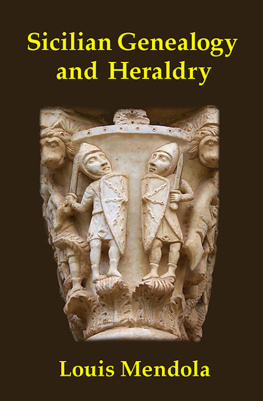A COMPLETE GUIDE
TO
HERALDRY
BY
ARTHUR CHARLES FOX-DAVIES
OF LINCOLNS INN, BARRISTER-AT-LAW
AUTHOR OF THE ART OF HERALDRY
EDITOR OF ARMORIAL FAMILIES, ETC. ETC.
ILLUSTRATED BY NINE PLATES IN COLOUR AND NEARLY
800 OTHER DESIGNS, MAINLY FROM DRAWINGS BY
GRAHAM JOHNSTON
HERALD PAINTER TO THE LYON COURT
CONTENTS
Too frequently it is the custom to regard the study of the science of Armory as that of a subject which has passed beyond the limits of practical politics. Heraldry has been termed the shorthand of History, but nevertheless the study of that shorthand has been approached too often as if it were but the study of a dead language. The result has been that too much faith has been placed in the works of older writers, whose dicta have been accepted as both unquestionably correct at the date they wrote, and, as a consequence, equally binding at the present day.
Since the Boke of St. Albans was written, into the heraldic portion of which the author managed to compress an unconscionable amount of rubbish, books and treatises on the subject of Armory have issued from the press in a constant succession. A few of them stand a head and shoulders above the remainder. The said remainder have already sunk into oblivion. Such a book as Guillim must of necessity rank in the forefront of any armorial bibliography; but any one seeking to judge the Armory of the present day by the standards and ethics adopted by that writer, would find himself making mistake after mistake, and led hopelessly astray. There can be very little doubt that the Display of Heraldry is an accurate representation of the laws of Armory which governed the use of Arms at the date the book was written; and it correctly puts forward the opinions which were then accepted concerning the past history of the science.
There are two points, however, which must be borne in mind.
The first is that the critical desire for accuracy which fortunately seems to have been the keynote of research during the nineteenth century, has produced students of Armory whose investigations into facts have swept away the fables, the myths, and the falsehood which had collected around the ancient science, and which in their preposterous assertions had earned for Armory a ridicule, a contempt, and a disbelief which the science itself, and moreover the active practice of the science, had never at any time warranted or deserved. The desire to gratify the vanity of illustrious patrons rendered the mythical traditions attached to Armory more difficult to explode than in the cases of those other sciences in which no one has a personal interest in upholding the wrong; but a study of the scientific works of bygone days, and the comparison, for example, of a sixteenth or seventeenth century medical book with a similar work of the present day, will show that all scientific knowledge during past centuries was a curious conglomeration of unquestionable fact, interwoven with and partly obscured by a vast amount of false information, which now can either be dismissed as utter rubbish or controverted and disproved on the score of being plausible untruth. Consequently, Armory, no less than medicine, theology, or jurisprudence, should not be lightly esteemed because our predecessors knew less about the subject than is known at the present day, or because they believed implicitly dogma and tradition which we ourselves know to be and accept as exploded. Research and investigation constantly goes on, and every day adds to our knowledge.
The second point, which perhaps is the most important, is the patent fact that Heraldry and Armory are not a dead science, but are an actual living reality. Armory may be a quaint survival of a time with different manners and customs, and different ideas from our own, but the word Finis has not yet been written to the science, which is still slowly developing and altering and changing as it is suited to the altered manners and customs of the present day. I doubt not that this view will be a startling one to many who look upon Armory as indissolubly associated with parchments and writings already musty with age. But so long as the Sovereign has the power to create a new order of Knighthood, and attach thereto Heraldic insignia, so long as the Crown has the power to create a new coronet, or to order a new ceremonial, so long as new coats of arms are being called into being,for so long is it idle to treat Armory and Heraldry as a science incapable of further development, or as a science which in recent periods has not altered in its laws.
The many mistaken ideas upon Armory, however, are not all due to the two considerations which have been put forward. Many are due to the fact that the hand-books of Armory professing to detail the laws of the science have not always been written by those having complete knowledge of their subject. Some statement appears in a textbook of Armory, it is copied into book after book, and accepted by those who study Armory as being correct; whilst all the time it is absolutely wrong, and has never been accepted or acted upon by the Officers of Arms. One instance will illustrate my meaning. There is scarcely a text-book of Armory which does not lay down the rule, that when a crest issues from a coronet it must not be placed upon a wreath. Now there is no rule whatever upon the subject; and instances are frequent, both in ancient and in modern grants, in which coronets have been granted to be borne upon wreaths; and the wreath should be inserted or omitted according to the original grant of the crest. Consequently, the so-called rule must be expunged.
Another fruitful source of error is the effort which has frequently been made to assimilate the laws of Armory prevailing in the three different kingdoms into one single series of rules and regulations. Some writers have even gone so far as to attempt to assimilate with our own the rules and regulations which hold upon the Continent. As a matter of fact, many of the laws of Arms in England and Scotland are radically different; and care needs to be taken to point out these differences.
The truest way to ascertain the laws of Armory is by deduction from known facts. Nevertheless, such a practice may lead one astray, for the number of exceptions to any given rule in Armory is always great, and it is sometimes difficult to tell what is the rule, and which are the exceptions. Moreover, the Sovereign, as the fountain of honour, can over-ride any rule or law of Arms; and many exceptional cases which have been governed by specific grants have been accepted in times past as demonstrating the laws of Armory, when they have been no more than instances of exceptional favour on the part of the Crown.
In England no one is compelled to bear Arms unless he wishes; but, should he desire to do so, the Inland Revenue requires a payment of one or two guineas, according to the method of use. From this voluntary taxation the yearly revenue exceeds 70,000, This affords pretty clear evidence that Armory is still decidedly popular, and that its use and display are extensive; but at the same time it would be foolish to suppose that the estimation in which Armory is held, is equal to, or approaches, the romantic value which in former days was attached to the inheritance of Arms. The result of this has beenand it is not to be wondered atthat ancient examples are accepted and extolled beyond what should be the case. It should be borne in mind that the very ancient examples of Armory which have come down to us, may be examples of the handicraft of ignorant individuals; and it is not safe to accept unquestioningly laws of Arms which are deduced from Heraldic handicraft of other days. Most of them are correct, because as a rule such handicraft was done under supervision; but there is always the risk that it has not been; and this risk should be borne in mind when estimating the value of any particular example of Armory as proof or contradiction of any particular Armorial law. There were heraldic stationers before the present day.













